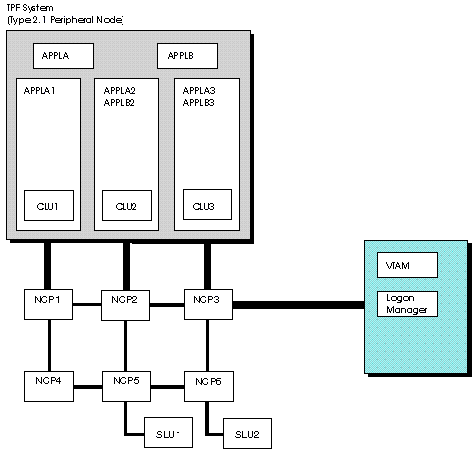 z/OS Communications Server: SNA Network Implementation Guide
z/OS Communications Server: SNA Network Implementation Guide
 z/OS Communications Server: SNA Network Implementation Guide
z/OS Communications Server: SNA Network Implementation Guide
|
Previous topic |
Next topic |
Contents |
Contact z/OS |
Library |
PDF
Sample logon manager configuration z/OS Communications Server: SNA Network Implementation Guide SC27-3672-01 |
|
|
Figure 1 shows a logon manager configuration
consisting of:
Figure 1. Sample Logon Manager
Configuration
 NCP1 through NCP3 are NCP Version 4 Release 3 subarea nodes, which are channel-attached to TPF. NCP3 is also channel-attached to VTAM. NCP1 through NCP6 are link-attached to each other. NCP4 through NCP6 do not have to be NCP Version 4 Release 3 or subsequent releases. CLU1 through CLU3 are control logical units (CLUs). They manage the flow of transactions from their associated subarea nodes. TPF is defined to VTAM as a type 2.1 peripheral node. Because the NCPs are channel-attached, TPF requires LNCTL=CA on the NCP GROUP definition statement. Interactions between logon manager and TPF occur in the form of control point LU to control point LU sessions. APPLA and APPLB are TPF application programs. They are defined to VTAM as local applications. Resources defined as independent LUs can initiate sessions with the TPF applications. To take advantage of multiple-channel attachments into the subarea network, each application program (for example, APPLA) needs at least one LU per channel attachment. In this configuration, each application program requires three or more LUs (for example, APPLA1, APPLA2, APPLA3) to use all channels into the network. Because APPLB has only two LU definitions, it can use only two channels into the network. SLU1 and SLU2 are defined to VTAM as dependent SLUs. They are link-connected to their associated subarea nodes and represent the remote terminal users of the TPF application programs. You can define class of service (COS) tables for a subarea configuration. For information about COS tables, see z/OS Communications Server: SNA Resource Definition Reference. 


|
 Copyright IBM Corporation 1990, 2014 Copyright IBM Corporation 1990, 2014 |